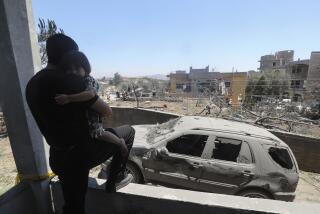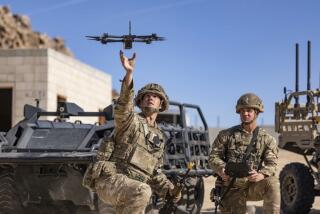Military Beefs Up Its Digital Arsenal
Even with a roomful of other high-tech wizardry, the show-stopper at a recent defense electronics conference in San Diego was a three-dimensional aerial image of Baghdad shown on a big-screen TV.
As a defense contractor gently moved the joystick, a mock aircraft nose-dived a few hundred feet above the city and the view from the cockpit changed significantly. The drab outlines of Baghdad quickly gave way to vivid satellite images of rooftops and tree-lined streets before the plane swooped over a car parked in front of Saddam Hussein’s Republican Guard headquarters.
This computer simulator is a commercial version based on defense work that has been declassified. But industry and military sources say U.S. forces are relying on digital information technology at an unprecedented level for a war against Iraq.
U.S. fighter pilots in the Middle East and Europe are now rehearsing for airstrikes against Iraq by using even more sophisticated computer simulators that project images of Baghdad and other potential targets, sources said. They offer three times more detail than commercial systems, with some shots taken by satellites only a few hours earlier, and are so precise that even slender electrical power lines are visible.
“Digital technology has permeated every facet of the military,” said Loren Thompson, defense analyst for the Lexington Institute and a lecturer at Georgetown University. “Every step in mounting a mission, executing it and planning the next one is being digitalized.”
Army commanders in Kuwait are also using a new computer system that allows them to instantly see on a laptop screen the precise location of U.S. tanks, artillery and other vehicles as well as information about their fuel level and supply of ammunition. Their orders are issued not from crackling radios, but from e-mails popping up on the computer screen. They also come from M-1 Abrams tanks fitted with hardened laptops, and remotely controlled spy planes with real-time video cameras.
The move to digitize U.S. forces started in earnest after the 1991 Persian Gulf War as computer processing power and the advent of satellite-based navigation systems raised the possibility of getting accurate information and then processing it instantly.
Among other things, the Pentagon hopes that digital communications will reduce the number of soldiers who mistakenly shoot their own. During the Gulf War, of the 148 U.S. soldiers killed, 35 died from “friendly fire.”
The ultimate goal of using supercomputers and Internet-like networks is to instantly link spy planes, satellites, fighters, bombers, tanks and ships so they can quickly identify targets and coordinate an attack -- within minutes, compared to hours or days in past conflicts. A decade ago pilots prepared for missions over Iraq using still photographs and maps while commanders used wall-size boards to chart troop movements based on radio communications that were prone to delays and mistakes.
Gen. Richard B. Myers, chairman of the Joint Chiefs of Staff, who attended the San Diego conference, described how in December the 82nd Airborne Division commander in Afghanistan was able to quickly respond to a report of U.S. soldiers coming under fire by merely looking at his computer. “The folks in Afghanistan get the information in a matter of minutes, a very accurate picture,” Myers said, noting how just a year earlier, the ground commander relied on grease pens and plastic-wrapped maps to figure out where everyone was.
“It’s in this area of shared knowledge that I think technology offers the promise of really transforming the military,” Myers added. “History is pretty clear: The ones that can do that the fastest usually win.”
It’s not clear how much the Pentagon has spent on information technology programs, but it has earmarked $30 billion over the next six years to continue beefing up the military’s communication and command and control systems. Another $50 billion is slated for new surveillance and reconnaissance systems.
Having superior knowledge has been a dream of military planners for centuries. Napoleon relied on reports from scouts in balloons for intelligence and room-size models of cities, down to a horse cart on a particular cobblestone street, to plan a military operation. During battles, Napoleon received battlefield reports via pigeons carrying small pieces with handwritten notes.
Against Iraq, U.S. forces are likely to use at least half a dozen different unmanned aircraft that have been developed over the last decade, including the Predator and Global Hawk as well the shorter endurance craft, Dragon Eye and Shadow, to give them aerial intelligence unlike ever before. High-altitude Global Hawks will provide wide-ranging, satellite-like images, while hand-launched Dragon Eyes will be able to provide live video images of a road or a clearing beyond a ridge or a forest.
“There has been a dramatic uptick with the advent of unmanned air vehicles and the ability to transmit videos,” said Steven J. Zaloga, a military technology analyst for the Fairfax, Va.-based aerospace research firm Teal Group. “Now you don’t need to build a model of Baghdad. You can use computers.”
At the San Diego conference, Joseph M. Nemethy, the product manager for defense contractor Harris Corp., used the joystick to fly over the Tigris River and head out of the city.
The system used a computer program developed by Harris, and images taken by commercial satellites using 3-meter-resolution cameras. By comparison, military satellites can generate images with three times more detail. The Harris software is incorporated into supercomputers developed by Mountain View, Calif.-based Silicon Graphics Inc., which turns the data into 3-D images.
Nemethy declined to talk about the military version of the system, but he said the technology is a dramatic improvement over the simulators that use animation to train commercial pilots. “The difference is the accuracy,” Nemethy said. “We actually use the imagery from satellites. We don’t fake the imagery.”
In Kuwait, U.S. tanks preparing for a possible invasion of Iraq have been fitted with computers that allow not only the commander miles away to see where his troops are and what they are doing but also give the tank driver the location and movement of other U.S. vehicles.
The screen displays a topographical map, either in 2-D or 3-D, with moving squares and triangles identifying the vehicles. Touching a particular square or triangle prompts the screen to display details of the vehicle, including the names of its occupants. If a tank crew spots the enemy, they alert others by touching another icon and typing in the enemy’s coordinates.
Recently, 12,500 soldiers from the Army’s 4th Infantry Division (Mechanized), based at Ft. Hood, Texas, were deployed to the Middle East. The unit is considered the army’s most modern combat division and has been testing the new system for more than three years in their M-1 tanks. The system, developed by Northrop Grumman Corp., was deployed late last year. And each computer unit, which resembles a laptop screen, is linked by satellites as well as secure radio and a global positioning system navigation device.
Defense analysts believe the latest information technology systems will come in handy if the conflict ends up in Baghdad, where house-to-house fighting could ensue. The Pentagon is betting that better communications and highly sophisticated information technology will provide an edge.
“The place where all this comes together is in the cockpit of a single fighter pilot or the tank driver penetrating hostile territory,” Thompson, the defense analyst, said. Soldiers will “have access to intelligence from satellites, ground sensors, a comprehensive awareness of where all the [friendly forces] and adversaries are, and he never loses contact with people below or above. It’s as though he has never left the command center.”
Eventually, the Pentagon envisions having all four services -- the Navy, Army, Air Force and Marines -- linked seamlessly, despite their disparate systems. All the major defense contractors, including Northrop Grumman, Boeing Co., Lockheed Martin Corp. and Raytheon Corp., have been vying for contracts to develop systems that would give the military so-called integrated battle space.
Analysts believe the Pentagon could spend up to $100 billion in the next decade to digitize its forces. Northrop, for instance, last fall created a Cyber Warfare Integration Center in El Segundo where a room resembling NASA’s mission control is filled with wall-to-wall screens and dozens of tables with computers.
However, there isn’t enough bandwidth to handle all the information the Pentagon wants to have, including transmitting live video images.
Some military planners are worried that commanders might micromanage squad leaders in the field. “Somebody sitting behind a desk at the Pentagon will be able to see in real time this stuff being fed to them by the soldier in the field and he may want to start telling the soldier what to do,” Zaloga said. “How they handle this is going to be one of the more interesting elements of the campaign.”
More to Read
Sign up for Essential California
The most important California stories and recommendations in your inbox every morning.
You may occasionally receive promotional content from the Los Angeles Times.










